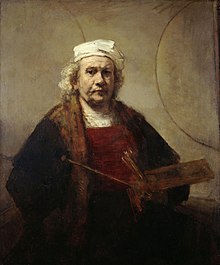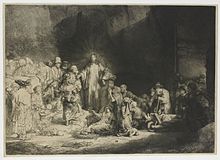User:Karakesek/Sandbox
Rembrandt | |
|---|---|
 Self portrait by Rembrandt (1661). | |
| Born | Rembrandt Harmenszoon van Rijn |
| Nationality | Dutch |
| Known for | Painting, Printmaking |
| Notable work | Danaë, 1636 Jacob de Gheyn III, 1632 |
| Movement | Dutch Golden Age painting |
Rembrandt Harmenszoon van Rijn (July 15, 1606 – October 4, 1669) was a Dutch painter and etcher. He is generally considered one of the greatest painters and printmakers in European art history and the most important in Dutch history.[1] His contributions to art came in a period that historians call the Dutch Golden Age.
Life[edit]

RembrandtCite error: A <ref> tag is missing the closing </ref> (see the help page).....
Periods, themes and styles[edit]

Throughout his career Rembrandt took as his primary subjects the themes of portraiture, landscape and narrative painting. For the last, he was especially praised by his contemporaries, who extolled him as a masterful interpreter of biblical stories for his skill in representing emotions and attention to detail.[3] Stylistically, his paintings progressed from the early 'smooth' manner, characterized by fine technique in the portrayal of illusionistic form, to the late 'rough' treatment of richly variegated paint surfaces, which allowed for an illusionism of form suggested by the tactile quality of the paint itself.[4] ....
Etchings[edit]

Rembrandt produced etchings for most of his career, from 1626 to 1660, when he was forced to sell his printing-press and virtually abandoned etching. Only the troubled year of 1649 produced no dated work.[5] He took easily to etching and, though he also learned to use a burin and partly engraved many plates, the freedom ....
Museum collections[edit]
In the Netherlands, the most notable collection of Rembrandt's work is at Amsterdam's Rijksmuseum, including De Nachtwacht (The Night Watch) and De Joodse bruid (The Jewish Bride). Many of his self-portraits are held in The Hague's Mauritshuis. His home, preserved as the Rembrandt House Museum in Amsterdam, displays many examples of his etchings; all major print rooms have the majority of these, although a number exist in only a handful of impressions (copies). The best collections of his paintings in other countries can be found in the National Gallery, London, Gemäldegalerie, Berlin, Hermitage Museum, St. Petersburg, Gemäldegalerie Alte Meister in Dresden, New York City, Washington, D.C., The Louvre and Kassel.[6] In addition, a number of Rembrandt paintings have been associated with Southern California individuals and institutions.
Night Watch[edit]

Rembrandt painted The Militia Company of Captain Frans Banning Cocq between 1640 and 1642. This picture was called the Nacht Wacht by the Dutch and the Night Watch by Sir Joshua Reynolds because, upon its discovery, the picture was so dimmed and defaced by time that it was almost indistinguishable and it looked quite like a night scene. After it was cleaned, it was discovered to represent broad day — a party of musketeers stepping from a gloomy courtyard into the blinding sunlight.
The piece was commissioned for the new hall of the Kloveniersdoelen, the musketeer branch of the civic militia. Rembrandt departed from convention, which ordered that such genre pieces should be stately and formal, rather a line-up than an action scene. Instead he showed the militia readying themselves to embark on a mission (what kind of mission, an ordinary patrol or some special event, is a matter of debate). Contrary to years of speculation, the work was hailed as a success from the beginning. Parts of the canvas were cut off (approximately 20% from the left hand side was removed) to make the painting fit on the designated wall when it was moved to Amsterdam town hall in 1715. However, the Rijksmueum contains a smaller reproduction of the work in what is understood to be its original form; the four, foremost figures occupy the painting's centre. The painting now hangs in the Rijksmuseum, Amsterdam, where it occupies the entire rear wall of the largest gallery.[7]
Expert assessments[edit]

In 1968 the Rembrandt Research Project was started under the sponsorship of the Netherlands Organization for the Advancement of Scientific Research; it was initially expected to last a highly optimistic ten years. Art historians teamed up with experts from other fields to reassess the authenticity of works attributed to Rembrandt, using all methods available, including state-of-the-art technical diagnostics, an...
Name and signature[edit]

"Rembrandt" is a modification of the spelling of the artist's first name that he introduced in 1633. Roughly speaking, his earliest signatures (ca. 1625) consisted of an initial "R", or the monogram "RH" (for Rembrant Harmenszoon; i.e. "son of Harmen"), and starting in 1629, "RHL" (the "L" stood, presumably, for Leiden). In 1632, he used this monogram early in the year, then a....
Optical theory[edit]
An article published in 2004[8], by Margaret S. Livingstone, professor of neurobiology at Harvard Medical School, suggests that Rembrandt, whose eyes failed to align correctly, suffered from stereo blindness. This conclusion was made after studying 36 of Rembrandt's self-portraits. Because he could not form a normal binocular vision, his brain automatically switched to one eye for many visual tasks. This disability could have helped him to flatten images he saw, and then put it onto the two-dimensional canvas. In Livingstone's words, this could have been a gift to a great painter like him, "Art teachers often instruct students to close one eye in order to flatten what they see. Therefore, stereo blindness might not be a handicap — and might even be an asset — for some artists." However, among Rembrandt's greatest talents was an ability to create the illusion of full volume, the perception of which requires healthy stereoptic vision.[citation needed]
References[edit]
- ^ Gombrich, p. 420.
- ^ Clough, p. 23
- ^ van der Wetering, p. 268.
- ^ van de Wetering, pp. 160, 190.
- ^ Schwartz, 1994, pp. 8-12
- ^ Clark 1974, pp. 147-50. See the catalogue in Further reading for the location of all accepted Rembrandts
- ^ As of October 2007, the main galleries remain closed for renovations, planned until 2010 but the Rembrandts are being shown in a nearby adjacent part of the building according to the Rijksmuseum website.
- ^ The New England Journal of Medicine, September 16, 2004
External links[edit]
Category:Dutch painters Category:Dutch engravers Category:Dutch Golden Age painters Category:Baroque painters Category:Portrait artists Category:People from Leiden Category:People from Amsterdam Category:Leiden University Category:1669 deaths Category:1606 births
